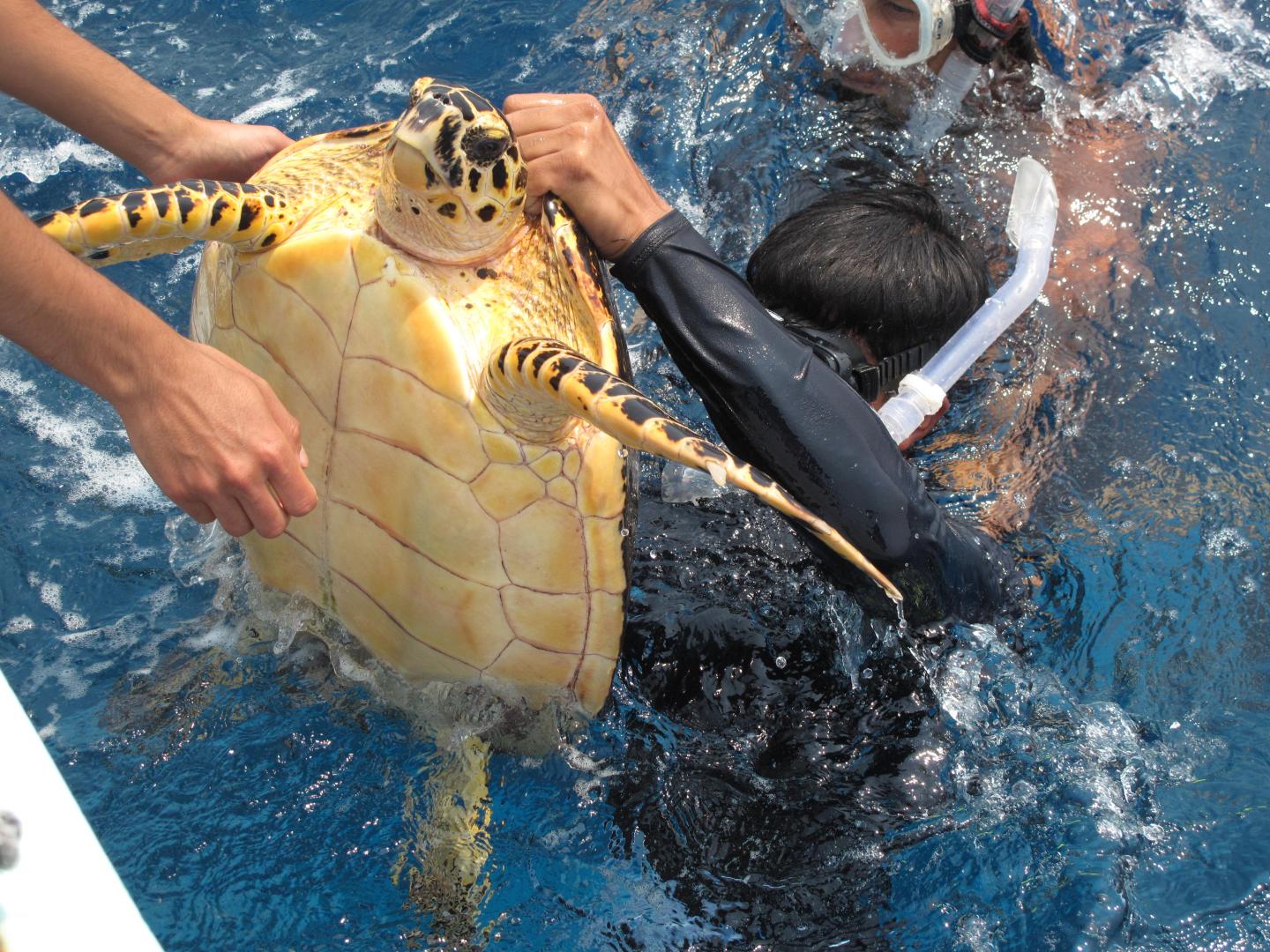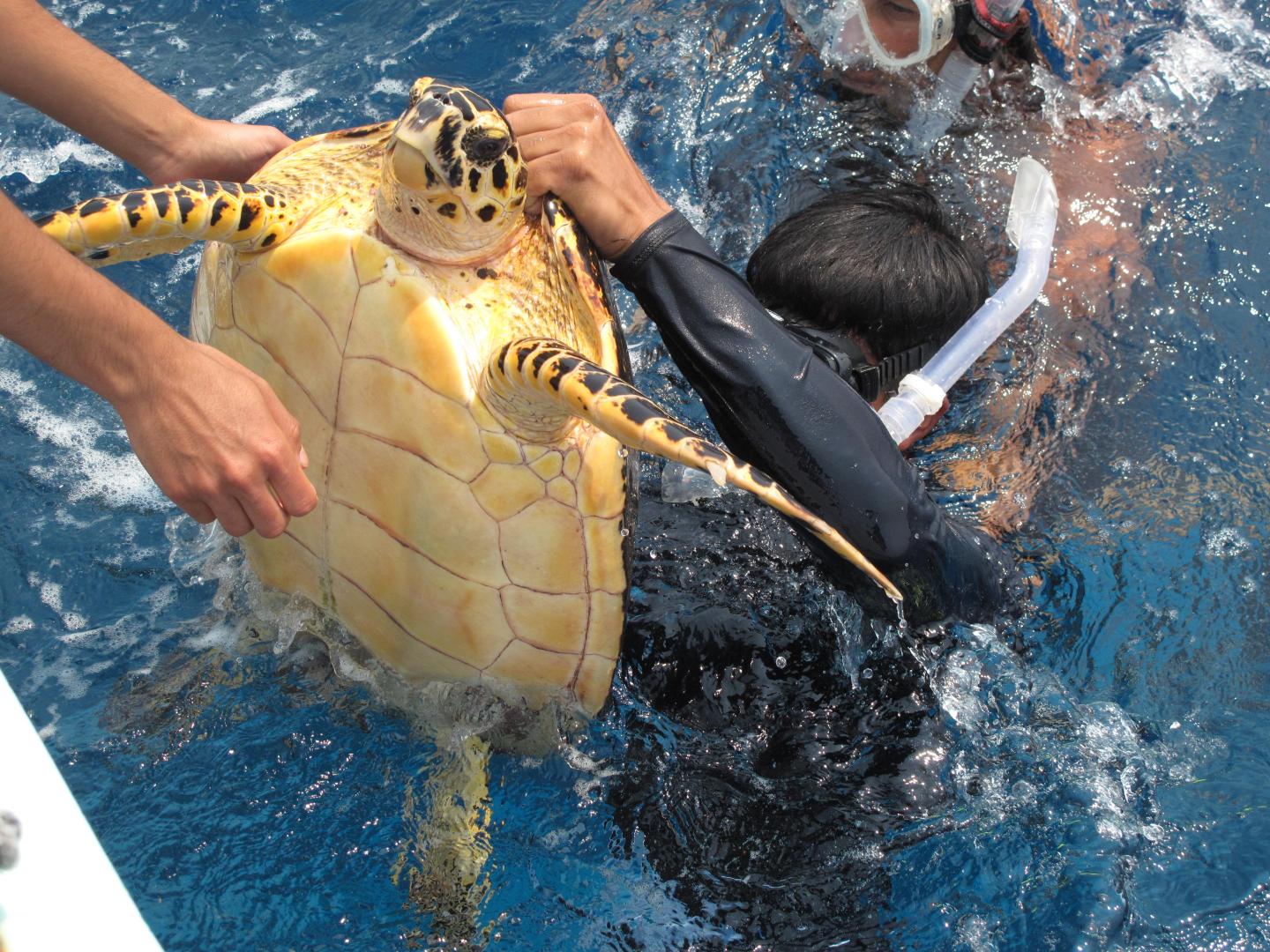
Credit: R. Coleman/WCS.
NEW YORK (November 29, 2016) –A new generation of threatened hawksbill sea turtles is thriving in the protected waters of Glover's Reef Atoll, Belize, evidence that efforts to protect these and other marine species in one of the world's great barrier reef systems are working, according to WCS (Wildlife Conservation Society) and the Belize Fisheries Department.
In a recently published study in the journal Endangered Species Research, scientists have reported that the coral reefs surrounding the atoll are home to more than 1,000 juvenile hawksbill sea turtles- good news for a species.
The authors of the study titled "In-water assessments of sea turtles at Glover's Reef Atoll, Belize" are: Samantha Strindberg, Virginia R. Burns Perez and Janet Gibson of WCS; Robin A. Coleman of WCS and Sawfish Consulting Ltd.; Cathi L. Campbell of WCS and the University of Florida, and Isaias Majil of the Belize Fisheries Department.
Study DOI: doi: 10.3354/esr00765
"The findings of our research show that juvenile hawksbill turtles are thriving at Glover's Reef- extremely good news for this endangered species," said Virginia Burns Perez, WCS Technical Coordinator in Belize. "Strongholds for the species such as this one should become a model for other foraging and nesting areas that are important for the hawksbill turtle."
Glover's Reef Atoll is part of the Mesoamerican Barrier Reef Reserve System, a UNESCO World Heritage Site and the second largest coral reef system in the Western Hemisphere. The Glover's Reef Marine Reserve, in particular, is important to both the fishing economy of Belize and the region's marine biodiversity. In order to safeguard this natural wonder, WCS worked with the Belize Fisheries Department and other local stakeholders to initiate a conservation plan for the site. The hawksbill sea turtle was selected as one of several target species for conserving the larger seascape.
"A healthy population of hawksbill turtles at Glover's Reef has positive implications for recovery of the species in Belize and the wider Caribbean region," said Nicole Auil Gomez, WCS Belize Country Director. "Once these young hawksbills mature they leave the Atoll and can travel incredible distances."
Meanwhile, Fisheries Administrator Beverly Wade stated that "This study validates the importance of the Glover's Reef Marine Reserve for the survival of such an iconic species. The thriving Hawksbill turtles are a wonderful success story for the government and people of Belize and its partners in their efforts toward the sustained management and conservation of the Glover's Reef Atoll."
The newly published study is the result of field research between 2007 and 2013, during which time 12 snorkel surveys on sea turtles were conducted in the coral reefs around Glover's Reef Atoll. Safe and tested methods were used to catch, examine, tag, and release sea turtles. From 2009 onward, for the first time ever for in-water assessments of turtles, a technique known as distance sampling (visually spotting sea turtles along a transect line and estimating distance between the turtle and the line) was used.
Complementary monitoring methods provided a comprehensive assessment of turtle population status and dynamics, while accounting for the proportion of turtles that were not caught or seen. "Our turtle monitoring protocol is based on robust survey and analysis methods," said WCS Scientist & Wildlife Statistician Samantha Strindberg. "This allows us to more confidently assess the effectiveness of conservation management for this important population of hawksbill turtles now and in the future."
Results of the study found that the abundance of juvenile hawksbill turtles was estimated to be more than 1,000 individual animals, with much smaller numbers of green and loggerhead sea turtles. The research team also determined that the probability of survival for the hawksbills was reassuringly high, another reason for optimism about the persistence of sea turtles at Glover's Reef Atoll.
"The discovery that Glover's Reef Atoll is an important habitat for young sea turtles is an important find, one that will enable regulatory agencies to fine-tune already effective management policies to safeguard a highly threatened species and its biodiverse habitat," said Jason Patlis, WCS's Director for Marine Conservation.
"This is great news on two levels: the discovery of a robust population of juvenile hawksbill sea turtles means a brighter future for this highly endangered species, and the protections afforded this population within the Glover's Reef Atoll once again demonstrates the importance and effectiveness of well-managed marine protected areas," added Patlis.
Glover's Reef Atoll is also the focus of a 167,000-gallon tank located in the New Conservation Hall and Glover's Reef exhibit at WCS's New York Aquarium. The exhibit replicates its diverse coral reef namesake in Belize and is home to marine creatures including eels, rays, hogfish, and many other species. Through powerful graphics, visitors are introduced to WCS's Glover's Reef Marine Research Station along with WCS studies on coral diversity, bleaching, and other conservation topics.
###
This research was possible thanks to the support of Oak Foundation.
To find out about WCS's conservation work in the seascape of New York and New Jersey, go to Blue York.
WCS (Wildlife Conservation Society)
MISSION: WCS saves wildlife and wild places worldwide through science, conservation action, education, and inspiring people to value nature. To achieve our mission, WCS, based at the Bronx Zoo, harnesses the power of its Global Conservation Program in nearly 60 nations and in all the world's oceans and its five wildlife parks in New York City, visited by 4 million people annually. WCS combines its expertise in the field, zoos, and aquarium to achieve its conservation mission. Visit: newsroom.wcs.org Follow: @WCSNewsroom. For more information: 347-840-1242.
Wildlife Conservation Society's New York Aquarium is open every day of the year. Summer hours are 10 a.m. to 6 p.m. daily. Fall/winter/spring hours are 10 a.m. to 4:30 p.m., daily. Tickets are $11.95 per person (ages 3 & up), and include Aquarium admission plus one admission to the new 4-D Theater; children age 2 and under are admitted free. Fridays after 4 p.m. in the summer and after 3 p.m. in the fall, Aquarium admission is by pay-what-you-wish donation. The aquarium is located on Surf Avenue at West 8th Street in Coney Island. The New York Aquarium is located on property owned by the City of New York, and its operation is made possible in part by public funds provided through the New York City Department of Cultural Affairs. For directions, information on public events and programs, and other aquarium information, call 718-265-FISH or visit our web site at http://www.nyaquarium.com. Now is the perfect time to visit and show support for the WCS New York Aquarium, a beloved part of Brooklyn and all of the City of New York. Due to Hurricane Sandy we are partially opened. Check our website for more information. http://www.nyaquarium.com.
http://www.wcs.org/
http://www.wcsgloversreef.org/
https://nyaquarium.com/
https://newsroom.wcs.org/News-Releases/articleType/ArticleView/articleId/6264/WCSs-New-York-Aquarium-Unveils-Its-New-Conservation-Hall-and-Glovers-Reef.aspx
http://www.int-res.com/abstracts/esr/v31/p211-225/
Media Contact
John Delaney
[email protected]
718-220-3275
@TheWCS
http://www.wcs.org
############
Story Source: Materials provided by Scienmag





